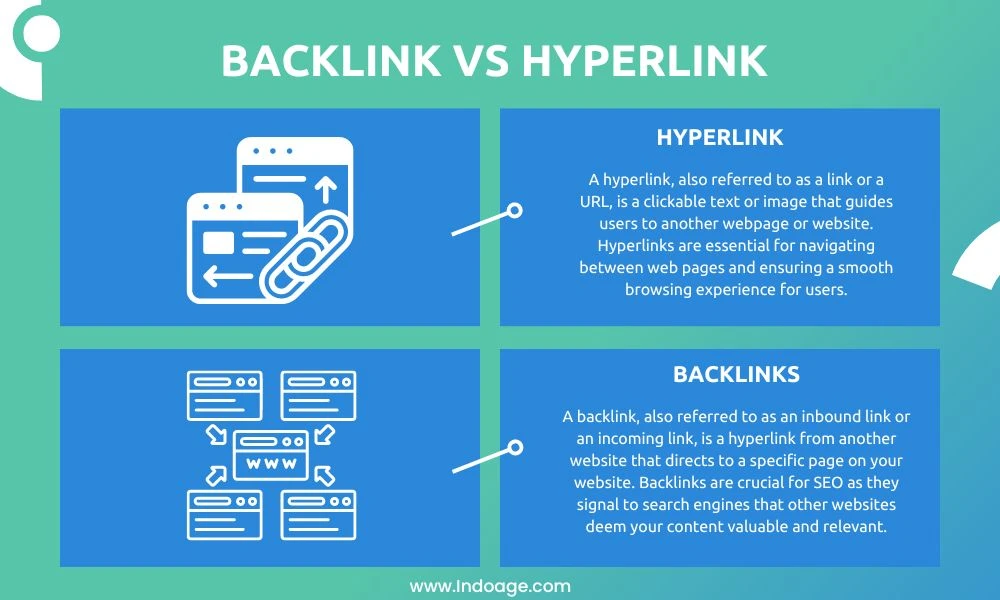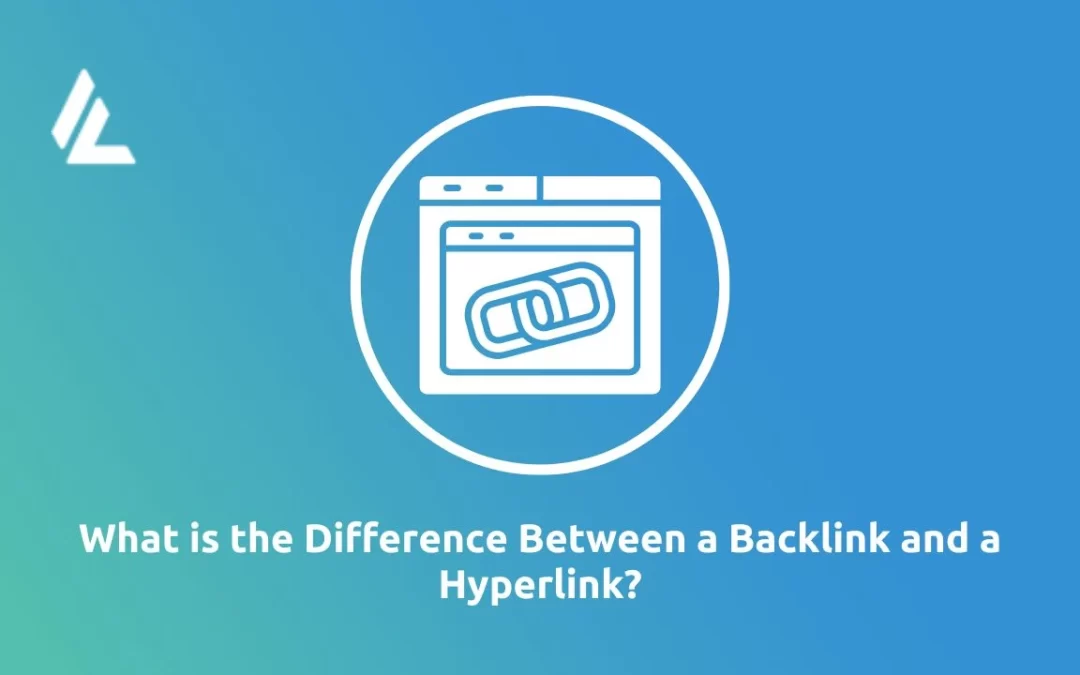Table of Contents
In the constantly changing world of digital marketing and SEO, the terms “backlinks” and “hyperlinks” are crucial, yet often misunderstood. Backlinks serve as digital endorsements, indicating a website’s credibility through recommendations from other online sources. Understanding the difference between a Backlink and a Hyperlink is extremely important for anyone involved in SEO.
These are vital for SEO, influencing a site’s authority and search engine rankings. On the other hand, hyperlinks are the navigational pathways of the internet, connecting web pages and enhancing user experience. They may not necessarily endorse content but play a crucial role in seamless navigation.
Understanding the distinct roles of backlinks and hyperlinks is essential for developing effective digital strategies that enhance visibility, credibility, and user engagement. Together, these elements contribute to a comprehensive approach to digital success.
In this blog post, we will delve into the variances between backlinks and hyperlinks, their significance, and how they contribute to a website’s overall performance.
Hyperlinks
A hyperlink, also referred to as a link or a URL, is a clickable text or image that guides users to another webpage or website. Hyperlinks are essential for navigating between web pages and ensuring a smooth browsing experience for users.
They can be internal, directing to different pages within the same website, or external, leading to other websites. Hyperlinks play a crucial role in the web, enabling users to easily access related content and explore the internet.
Hyperlinks can be inserted into text, images, or email addresses, allowing visitors to navigate or browse the hypertext. They are commonly used on the web to offer navigation, reference, and depth where published text falls short.
Check out our blog post on How long does Google take to build SEO links, for more comprehensible knowledge.
Backlinks
A backlink, also referred to as an inbound link or an incoming link, is a hyperlink from another website that directs to a specific page on your website. Backlinks are crucial for SEO as they signal to search engines that other websites deem your content valuable and relevant. When a website links to your site, it passes on some of its authority and credibility, which can enhance your search engine rankings.
Backlinks can take various forms, including text links, image links, or links embedded in buttons or infographics. They can also be classified as Dofollow or Nofollow links, depending on whether they transfer SEO value to the linked page.
Dofollow links enable search engine crawlers to follow the link and index the linked page, while nofollow links do not transfer SEO value and are used for non-SEO purposes, such as social media sharing or user experience.
Inbound links, also known as backlinks, are links from other sites that point to your site. They are crucial for SEO as they are one of the most influential ranking signals used by Google to rank websites and web pages in search engine results. Inbound links are considered high-quality if they originate from reputable, relevant websites, and they can enhance your website’s authority and credibility.
Also, check out our blog post where we have discussed your question on “How many backlinks do I need to rank?”

Key Differences- What is the Difference Between a Backlink and a Hyperlink?
The main differences between backlinks and hyperlinks lie in their purpose, origin, and impact on SEO:
1. Purpose:
Hyperlinks are crucial for creating a smooth and user-friendly online environment. They help users navigate between web pages effortlessly, improving the overall user experience. Whether guiding users through internal content or directing them to external sources, hyperlinks contribute to the well-organized structure of digital platforms.
On the other hand, backlinks play a unique role in search engine optimization (SEO) and website credibility. They function as virtual endorsements from other websites, signaling to search engines the value, reliability, and relevance of a site’s content.
The quality and quantity of backlinks directly impact a website’s authority and its positioning in search results. Therefore, a thoughtful combination of strategic hyperlinks for user satisfaction and purposeful backlinks for SEO efforts forms the foundation of a comprehensive digital strategy, optimizing both user experience and online visibility.
2. Origin:
The difference between hyperlinks and backlinks lies in their directional and navigational characteristics. Hyperlinks can take two forms: internal or external. Internal hyperlinks connect various pages within the same website, providing smooth navigation for users exploring related content on the same domain.
On the other hand, external hyperlinks direct users to pages on other websites, broadening the range of information available to the user. Conversely, backlinks are exclusively external, originating from other websites. These incoming links act as virtual endorsements, indicating to search engines the credibility and relevance of the linked-to website’s content.
3. Impact on SEO:
Backlinks and hyperlinks each have distinct but complementary roles in shaping a website’s digital presence. Backlinks directly impact a website’s SEO by serving as endorsements from other sites, signaling to search engines the value and relevance of the linked content. The accumulation of high-quality backlinks enhances a site’s authority and can positively influence its search engine rankings.
On the other hand, hyperlinks, both internal and external, do not directly impact SEO but are fundamental for user experience and website navigation. Internal hyperlinks guide users seamlessly within a website, creating a cohesive and engaging browsing experience, while external hyperlinks broaden the information landscape by connecting users to related content on other websites.
You can also check our blog post on how to measure SEO link-building campaigns effectively to increase the success of your backlink strategies.
Importance of Backlinks and Hyperlinks
Both backlinks and hyperlinks play crucial roles in the success of a website:
1. Backlinks:
Backlinks are powerful signals for search engines, impacting a website’s search rankings by indicating that external sources consider the content valuable and relevant. These endorsements significantly contribute to a site’s perceived authority and credibility, as search algorithms view the accumulation of high-quality backlinks as a vote of confidence from other reputable sites.
Additionally, building a strong link profile with quality backlinks is crucial for enhancing a website’s overall credibility and authority within its niche.
This network of links not only helps improve search rankings but also strengthens the website’s reputation as a trustworthy and authoritative source for both search engines and users.
2. Hyperlinks:
Hyperlinks are essential for improving user experience and enabling smooth website navigation. They allow users to easily access related content and explore the vast expanse of the internet. Internal hyperlinks, in particular, help establish a strong internal linking structure within a website.
This interconnected network of pages not only guides users logically through the site but also indirectly contributes to the website’s SEO efforts. A well-designed internal linking structure helps search engine crawlers understand the hierarchy and relationships between different pages.
This can potentially lead to improved indexation and search engine rankings. Therefore, while hyperlinks primarily serve the user-centric aspects of website design, their contribution to building a strong internal linking framework can have positive implications for a website’s overall SEO strategy.
Check out how we at IndoAge create a winning backlink strategy with our Digital Marketing Services.
Conclusion
In conclusion, the distinct purposes and characteristics of backlinks and hyperlinks underscore their critical roles in a website’s success. Backlinks are crucial for enhancing a website’s SEO and credibility, as they serve as valuable endorsements from other sites, signaling relevance and authority to search engines.
On the other hand, hyperlinks are essential for optimizing navigation and user experience, guiding users seamlessly through a website, and facilitating exploration of related content. Understanding the nuanced differences between these two link types is essential for website owners aiming to devise a comprehensive SEO strategy and elevate their online presence.
By strategically leveraging both backlinks and hyperlinks, webmasters can create a synergistic approach that addresses the dual goals of search engine visibility and an enhanced user experience, ultimately contributing to the overall success of the website.

